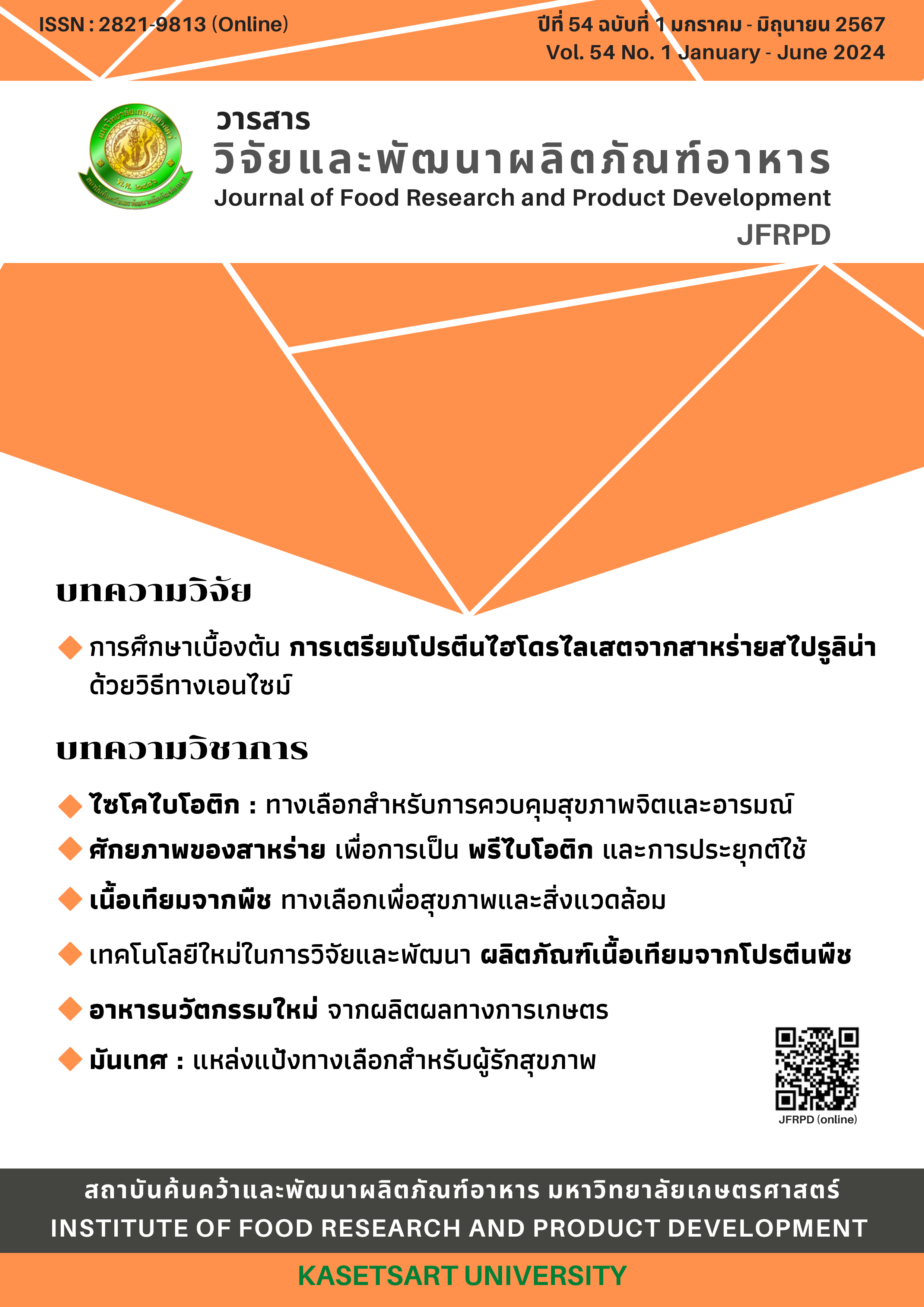The potential of algae as a prebiotic and application
Main Article Content
Abstract
The global population is interested in healthy food consumption, nutritional trends, and sources of prebiotics. Algae are rich in nutritional composition, including carbohydrates, protein, and unsaturated fatty acids, and they have high biological properties. Polysaccharide from algae has prebiotic potential and can be applied to health food product corporations. There are antioxidants, anticancer, lower blood pressure, and biological activities. This review provides an overview of algae, including macro- and micro-algae, as well as nutrition, prebiotic, and food applications. The interaction of algae prebiotic and probiotic are combined, and their health benefits.
Downloads
Article Details

This work is licensed under a Creative Commons Attribution-NonCommercial-NoDerivatives 4.0 International License.
References
Terpou A, Papadaki A, Lappa IK, Kachrimanidou V, Bosnea LA, Kopsahelis N. Probiotics in food systems: Significance and emerging strategies towards improved viability and delivery of enhanced beneficial value. Nutr. 2019;11(7):1591.
Patel AK, Singhania RR, Awasthi MK, Varjani S, Bhatia SK, Tsai M-L, et al. Emerging prospects of macro- and microalgae as prebiotic. Microb Cell Fact. 2021;20(1):112.
Gotteland M, Riveros K, Gasaly N, Carcamo C, Magne F, Liabeuf G, et al. The pros and cons of using algal polysaccharides as prebiotics. Front Nutr. 2020;7.
Dawczynski C, Schubert R, Jahreis G. Amino acids, fatty acids, and dietary fibre in edible seaweed products. Food Chem. 2007;103(3):891-9.
Vassilev SV, Vassileva CG. Composition, properties and challenges of algae biomass for biofuel application: An overview. Fuel. 2016;181:1-33.
Babich O, Ivanova S, Michaud P, Budenkova E, Kashirskikh E, Anokhova V, et al. Fermentation of micro- and macroalgae as a way to produce value-added products. Biotechnol Rep. 2024;41:e00827.
YalÇIn D, Ilikkan Ö, BaĞDat E. Evaluation of prebiotic, probiotic, and synbiotic potentials of microalgae. Food Health. 2022;8(2):161-71.
Ilknur B, Birsen K, Hamideh M. Major Natural Vegetation in Coastal and Marine Wetlands: Edible Seaweeds. In: Manuel TO, Feyza C, Anabela F-S, editors. Plant Communities and Their Environment. Rijeka: IntechOpen; 2019. p. Ch. 9.
Lewmanomont K. Some Edible Algae of Thailand. Agr Nat Resour. 1978;12(2):119-33.
Andrade L, De Andrade CJ, Dias M, Nascimento C, Mendes M. Chlorella and spirulina microalgae as sources of functional foods, nutraceuticals, and food supplements; an overview. MOJ Food Process Technol. 2018;6:00144.
Rajapakse N, Kim S-K. Chapter 2 - Nutritional and Digestive Health Benefits of Seaweed. In: Kim S-K, editor. Advances in Food and Nutrition Research. 64: Academic Press; 2011. p. 17-28.
Thiviya P, Gamage A, Gama-Arachchige NS, Merah O, Madhujith T. Seaweeds as a source of functional proteins. Phycol. 2022;2(2):216-43.
Wang Y, Tibbetts SM, McGinn PJ. Microalgae as sources of high-quality protein for human food and protein supplements. Foods. 2021;10(12).
Duttaroy AK. Chapter 8 - Polysaccharide on diabetes, obesity, and other cardiovascular disease risk factors. In: Duttaroy AK, editor. Evidence-Based Nutrition and Clinical Evidence of Bioactive Foods in Human Health and Disease: Academic Press; 2021. p. 115-28.
Babich O, Sukhikh S, Larina V, Kalashnikova O, Kashirskikh E, Prosekov A, et al. Algae: study of edible and biologically active fractions, their properties and applications. Plants [Internet]. 2022; 11(6).
Rodrigues D, Freitas AC, Pereira L, Rocha-Santos TA, Vasconcelos MW, Roriz M, et al. Chemical composition of red, brown and green macroalgae from Buarcos bay in Central West Coast of Portugal. Food Chem. 2015;183:197-207.
Cindana Mo’o FR, Wilar G, Devkota HP, Wathoni N. Ulvan, a polysaccharide from macroalga Ulva sp.: a review of chemistry, biological activities and potential for food and biomedical applications. Appl Sci. 2020;10(16):5488.
Lopez-Santamarina A, Miranda JM, Mondragon ADC, Lamas A, Cardelle-Cobas A, Franco CM, et al. Potential use of marine seaweeds as prebiotics: a review. Mol. 2020;25(4).
Moreira JB, Vaz BdS, Cardias BB, Cruz CG, Almeida ACAd, Costa JAV, et al. Microalgae polysaccharides: an alternative source for food production and sustainable agriculture. Polysaccharides. 2022;3(2):441-57.
Shannon E, Abu-Ghannam N. Seaweeds as nutraceuticals for health and nutrition. Phycologia. 2019;58(5):563-77.
Paola Scodelaro B, Gabriela AS, Patricia IL. Fatty acids from microalgae: targeting the accumulation of triacylglycerides. in: angel C, editor. Fatty Acids. Rijeka: IntechOpen; 2017. p. Ch. 7.
Rondevaldova J, Quiao MA, Drabek O, Dajcl J, Dela Pena-Galanida GD, Leopardas VE, et al. Mineral composition of seaweeds and seagrasses of the Philippines. Phycologia. 2023;62(3):217-24.
Škrovánková S. Seaweed vitamins as nutraceuticals. Adv Food Nutr Res. 2011;64:357-69.
Gentscheva G, Nikolova K, Panayotova V, Peycheva K, Makedonski L, Slavov P, et al. Application of Arthrospira platensis for medicinal purposes and the food industry: a review of the literature. Life (Basel). 2023;13(3).
Sonchaeng U, Wongphan P, Pan-utai W, Paopun Y, Kansandee W, Satmalee P, et al. Preparation and characterization of novel green seaweed films from Ulva rigida. Polymers. 2023;15(16):3342.

